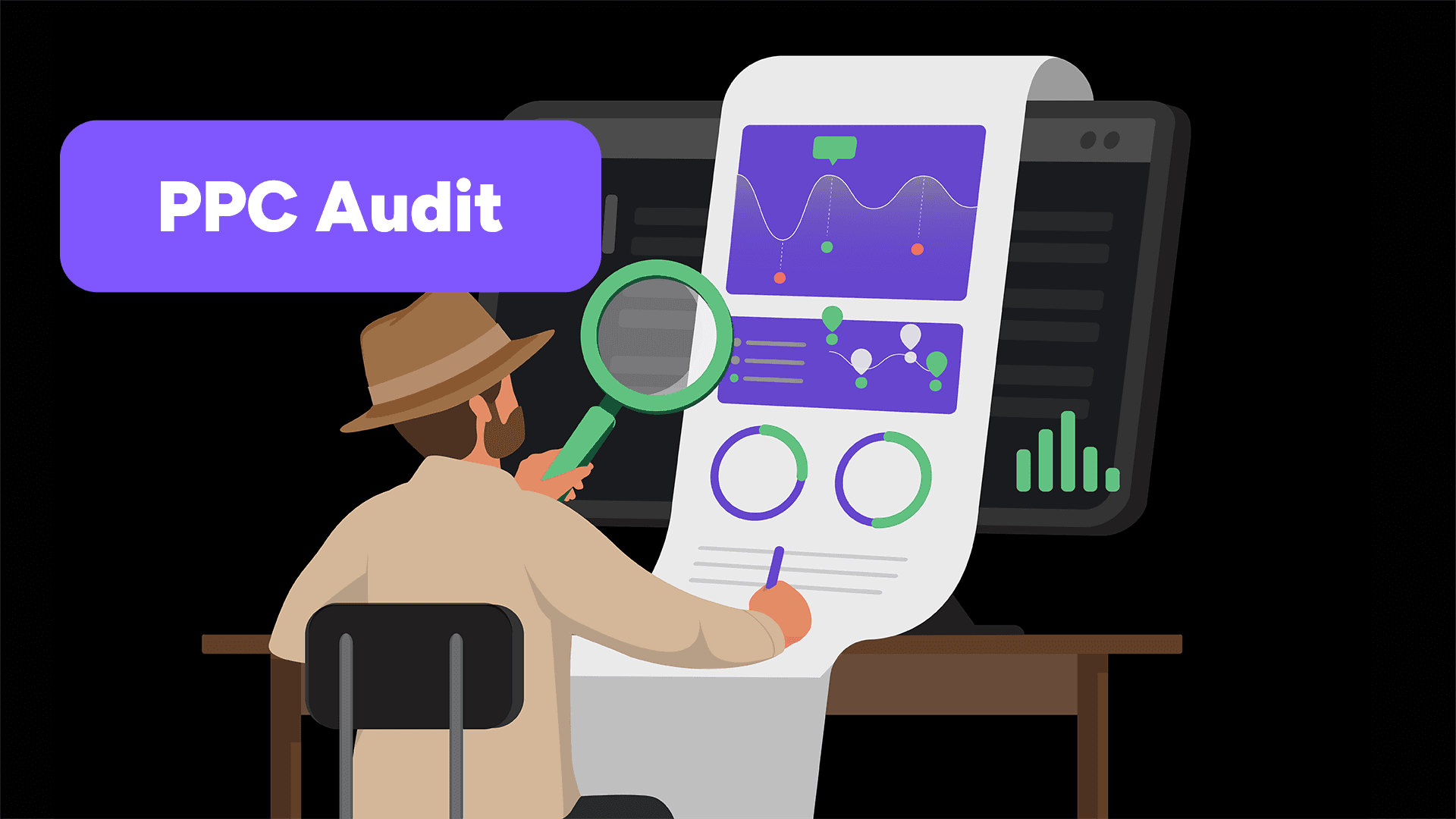
Doing a PPC audit will help you understand exactly where your current PPC efforts stand, and help you pinpoint every single improvement you can make.
The PPC audit is where we always start for any new project we're taking on.
This article is going to show you exactly how we run PPC audits for hundreds of clients.
💡 Later on we're also going to share a free copy of the exact PPC audit template we use for our clients.
What Is a PPC Audit?
A PPC audit is a complete analysis of your PPC account. It aims to discover areas that you can improve to increase your PPC ROI.
A comprehensive PPC audit should look at a big range of factors including performance, budgeting, targeting, conversion tracking, bidding strategy and more.
The goal is to figure out what's working and what needs improved.
Running a poor PPC campaign is like lighting money on fire 🔥

Benefits
Auditing your account is essential if you want to ensure you are getting the most value for your ad spend. If you don’t perform these checks, you won’t know if you’re spending your budget efficiently.
Here are some of the reasons & benefits of PPC audits:
- Prevent Waste - For example, you may be targeting keywords that aren’t delivering, or certain landing pages may not be converting as well as they could.
- Spot Technical Issues - Technical issues can cause havoc for your ad spend. If your PPC conversion tracking isn’t set up correctly on one of your web properties, your data will be all wrong.
- Review Goals - Performing an audit can help you reassess your goals and ensure your account is working to meet them.
When Should You Conduct a PPC Audit?
Whether you're an in-house marketer, company owner or external agency, we recommend running a PPC audit every 6 months.
Of course, the very first PPC audit you run on a new account is always going to be the most time-consuming.
After the first one is completed, subsequent audits should be done every 6 months to make sure you're still on the right path and that the account hasn't accidentally swayed away from your original goals.
Even the best marketers in the World can make mistakes, and that's why having a regular audit system in place is so important - The system allows you to easily spot mistakes, and because it's a checklist, it's easy to go through each particular part.
Auditing high-performing PPC accounts is just as important as auditing ones that are delivering less impressive results.
However, you may want to increase the frequency of audits on poorly performing accounts.
We wouldn’t audit an account if we had recently made significant changes to it. That’s because you need to build up a library of data that shows how the changes affect account performance.
For example, if you’ve just built a series of new landing pages, it will take time to gather enough data to show how the changes have impacted performance..
How Do I Run a PPC Audit?

We're going to run through all of the steps of the audit now below.
Before you go to the next step, make sure you have all of the data available to you, which means:
- Google Ads Account Access
- Google Analytics + Tag Manager
- Competitor Analysis Software (not essential)
- Basic understanding of PPC Marketing - see PPC training courses here
Access Our Free PPC Audit Template
👉 Access our free PPC audit template here.
Most of the questions are yes/no answers, and we also included a notes section for convenience.
This is the exact PPC audit we use at our agency.
1) Evaluate Business Goals
This is by far the most important part of any PPC audit.
If you don’t have a very clear understanding of the business financials and exactly what the business goals are, you will struggle to run a World-class PPC account.
That may sound like a controversial statement, and you certainly won’t hear that in any other PPC audit guide, but hear me out.
Ask Yourself...
Why are you investing in ads in the first place?
Obviously it’s to get more customers & more revenue, but it's important to get very specific.
For Example:
- A SaaS company might want to double demo calls for their product.
- An Ecommerce company might want to double their sales.
- A law firm might want to double their number of cases.
Write down your specific PPC goals.
Business Goals Checklist ✅
Now we have some actionable goals, we need to answer some more financial questions:
- What is your Net Profit Margin %?
- What is your Average Order Value?
- What is your Customer Lifetime Value?
- What is your current Monthly Revenue?
- What is your target Monthly Revenue?
- How many leads does it take you to land a sale? (Services or B2B only)
- What is your target cost to acquire a customer? (doesn’t have to be exact)
- What is your target ROAS? (e.g. 4X)
- Do you have a target ad budget spend per month?
- How many monthly conversion are you aiming for?
If you don't have all of your numbers in place, how can you expect to know what PPC success looks like?
If you're working for an agency or in the marketing department, then you need to collaborate with your management team to get these numbers accurate and down on paper.

Now let's look at a real-life example...
Example
At my other SEO agency, we were considering whether to invest in paid advertising, so we ran some numbers…
- Our net profit margin was 50%
- Our average order value was $5,000
- Our customer lifetime value was $25,000
- Our monthly revenue was $500,000
- Our target monthly revenue was $750,000
- It took as 3 qualified leads to land a sale
- If we could acquire a customer for anything less than $4,000, it would’ve been a great result!
- Our target ROAS was 500%
- Our target monthly ad budget was $50,000
So with all of that data, we can now make some pretty clear goals for PPC:
- Generating 12-13 new customers per month (real conversions) would’ve been great.
- Generating 36-40 qualified leads would help us get there (since it took 3 leads for every 1 sale).
- And since we worked through all the numbers, we knew that generating a new customer for $4,000 or less from PPC would’ve been a great business outcome for us.
Yes / No Answers
For the rest of our PPC audit, you simply have to mark 'Yes' or 'No' to each and every one of the questions below.
Of course if you mark 'No' you'll also want to take some notes on why that is, and what you can do to fix it.
We designed our PPC audit template this way to make it very easy to follow along.
2) Evaluate Current PPC Performance

Now that we have our business goals clearly defined and understood, let's dive into the first part of our audit, which is to evaluate the current performance of the PPC account.
The goal is to discover if current performance is meeting expectations in terms of results & budget.
Performance Checklist ✅
- The account is meeting budget target -
- That means to check that we're spending at or around the current budget.
- If the answer is yes, then great, there may be scope to increase budget depending on our other answers.
- If the answer is no, it may be that we're limited by impression-share or just not being expansive enough with our campaigns.
- The account is hitting the conversion, tCPA or tROAS target -
- This is a more obvious one - Linked directly to our conversion targets within the account.
- If the answer is yes, we're hitting our targets, then excellent!
- If the answer is no, it's an indication that either something is wrong, or that our tCPA or tROAS targets are too ambitious.
- Recent performance is consistent (vs Month on Month and/or Year on Year) -
- It's important to look at historical performance when auditing your PPC account.
- Does the pattern look generally consistent? Or have results changed drastically within the last month or the last year? (short term vs. long term)
- Is the lead quality strong? (for lead-generation accounts only)
- Run checks on lead quality to ensure they're relevant and good leads.
- Here you're really just checking to make sure a ton of spam or completely irrelevant leads aren't coming through.
- No campaign is eating lots of ad spend with minimal results -
- The goal of this point is to run a high-level check to ensure that we don't have any outlier campaigns wasting lots of ad budgets.
- Of course, certain types of discovery campaigns are going to have weaker performance, but this point serves as a sense-check to make sure nothing is drastically wrong.
- Google automatic recommendations have been reviewed -
- Google provides automatic "recommendations" within Google ads, driven by AI.
- It's important that we have reviewed & sense checked all of those recommendations.
- If the answer is no, then you should carefully go through each recommendation and decide whether that's something you want to implement.
- Example recommendations would be to raise your budgets, or to create a performance max campaign.
3) Budget

The purpose of auditing our budget is primarily to see how spend is being allocated across the account.
Because what often happens is that an account will become bloated over time, and more budget might be mis-allocated to the wrong campaigns.
Budget Checklist ✅
- Budgets are balanced
- For example, there's a good balance between your top of funnel vs. middle of funnel vs. bottom of funnel campaigns. Read more about the paid search funnel here.
- We wrote more about budget allocations in this guide.
- Important campaigns are not limited by budget
- Google will normally flag up if a campaign is limited by budget.
- If that's an incredibly well-performing campaign, you may just want to check whether it makes sense to raise that budget or re-allocate budget from other under-performing campaigns.
- If using shared budgets, there's a good reason for it
- Google's automation wants to control your overall account budget and pour more money into the campaigns it sees working
- The problem is, it'll often end up neglecting your top of funnel campaigns because it sees them as having a weaker performance, without looking at the bigger picture (You need discovery so people find your brand!).
4) Conversions & Attribution

This next step is the most technical part of our PPC audit.
It involves checking our conversions & attributions to ensure that we're tracking the right data and have an accurate picture of performance.
Conversion / Attribution Checklist ✅
- Do conversion goals make sense?
- Are you tracking clear & obvious macro conversions such as form fills, phone calls and call scheduling?
- Are you tracking micro conversions as well such as newsletter signups?
- Are conversion values / offline conversions being pulled through from CRM?
- This gives us an even more exact / accurate view of our advertising performance.
- Is other data e.g. Lead qualification being pulled through from CRM?
- Are you actively qualifying the leads that are coming in via Google ads?
- If this information isn't being fed back to Google ads, it will almost certainly be impacting your performance!
- Attribution model isn't Last-click, unless there's a good reason for it to be.
- Ensure that the attribution model is data-driven for better accuracy rather than last-click.
- Conversion goal(s) imported from Google Analytics
- Make sure that any conversion goal(s) that are present in GA have all been imported into Google Ads.
- Google Ads conversion tag implemented
- Test to see that the Google Ads tag has been accurately implemented across the website.
- Include in ‘Conversions’ is set to Yes on 1 conversion, not both
- This is important to ensure that you don't count multiple conversions from the same customer.
- For example, if somebody fills out a form AND phones your business, that should only count as 1 single conversion.
- [Optional / Not ecommerce] Conversions are set to count once
- Same logic as above - we only want to count conversions once per user.
- "Calls from ads" is added as a conversion event.
- Make sure that any calls that come in directly from the ads themselves (before clicking through to your website) is added as a conversion event.
- Conversion linker tag is added to GTM
- Auto-tagging is enabled
We love to use attribution tools to help us get a better picture of exactly what's going on.
Honestly, the best tool to use is Google's own (Free) attribution reporting within Google Analytics, at least for beginners.
Bonus - Check for abnormalities
Be sure to check the conversions of each campaign to keep an eye out for abnormalities.
- Campaigns with no conversions: This either means you aren’t tracking conversions, or no one is taking you up on your offer. While neither of these options is good, you can fix the former option by repairing your tracking.
- Campaigns with suspiciously high conversion rates: The higher your conversion rate the better, but a rate that’s too high can suggest you have a tracking problem. Compare the number of conversions shown in your PPC dashboard with actual conversions (sales, email signups, etc.) to confirm whether the rate makes sense. If it doesn’t match, your PPC campaign may be tracking the wrong metrics. For example, it may be counting page visits as conversions rather than sales.
- Identical click and conversion rates: If your click and conversion rates are exactly the same, you’ve probably set your campaign to track visits to your landing page rather than the confirmation page. You’ll need to adjust your tag. Either that or you’re an advertising genius.
5) Account Structure
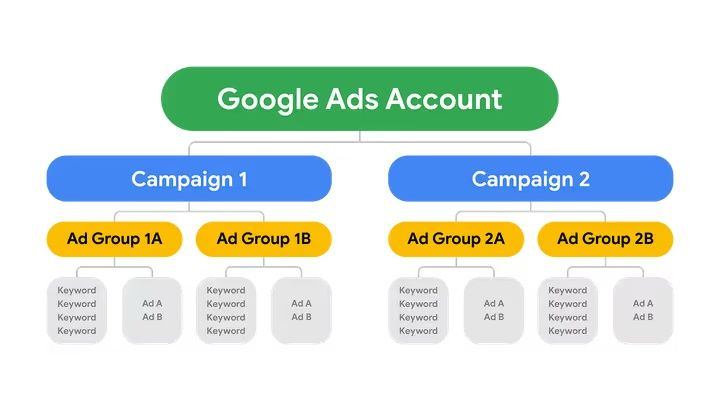
Google Ads account structure is the one thing that we most see wrong when auditing PPC accounts.
We've put together a list of checks to make on your account structure.
Account Structure Checklist ✅
- There are logical campaign splits
- For example, campaigns are split by overall primary category or by geographical location.
- No Search Display Expansion campaigns
- Make sure you're not running search display expansion campaigns as default.
- These will eat up budget and usually drive unqualified leads.
- Geographic targeting makes sense
- Just sense-check this point.
- Make sure you're not targeting any low-value locations or locations you don't serve to.
- Location options set to "Presence: People in or regularly in your targeted locations"
- This lets Google to accurately target the right people.
- Ad Rotation Settings - Set to "Optimize"
- This lets Google's machine learning select the best performing ads to the right people.
- Appropriate bid strategy applied
- a sense-check to see that the right bidding is applied for each campaign.
- Ad schedule makes sense
- For example, an accountant may not want to serve ads on a Saturday night!
- Keep in mind that nowadays, Google's machine-learning does a better job of serving ads at the right time to maximize conversions.
- Automatic ad creation turned off
- Search Partner performance warrants them being enabled
- Brand negative keyword list exists and applied
- Make sure that you're not getting unwanted clicks for people searching for similar brand names!
6) Bidding

This is an incredibly vital part of the PPC audit, where some analytical skills are required to determine that the strategy is correct.
We've put together a separate guide all about the optimal bidding strategy to help you out too.
Bidding Checklist ✅
- Brand campaigns are set to target impression share
- We want to typically try to maximize the impression share for our own brand!
- Especially if competitor's are bidding on our brand as well.
- Campaigns using manual bidding are doing so for a good reason
- Automated bidding (aka smart bidding) will almost always outperform manual bidding.
- So if you're using a manual bidding strategy, you should have a very good reason!
- That might include incredibly low amounts of data, or very clear evidence that it has outperformed a smart bidding strategy.
- Campaigns using smart bidding have good, reliable data
- If you're using a smart bidding strategy like tCPA or tROAS, you should have sufficient conversion data.
- We recommend a minimum of 30-50 conversions per month.
- Any lower than this, and Google's machine learning algorithm will struggle to optimize adequately.
- Smart bidding targets are realistic
- For example, if you know your industry tCPA (target cost per action) is $200, then you shouldn't have it set to $50!
- This will cause significant underperformance.
- And in all likelihood, it will cause Google to send you lower value customers as well.
- If device bidding restrictions apply, there's a good reason
- If the account has restricted certain devices, have a good reason why.
- It's true that some devices will be much more important than others for certain industries, but cutting off an entire device needs a very good reason!
7) Account Assets (Extensions)
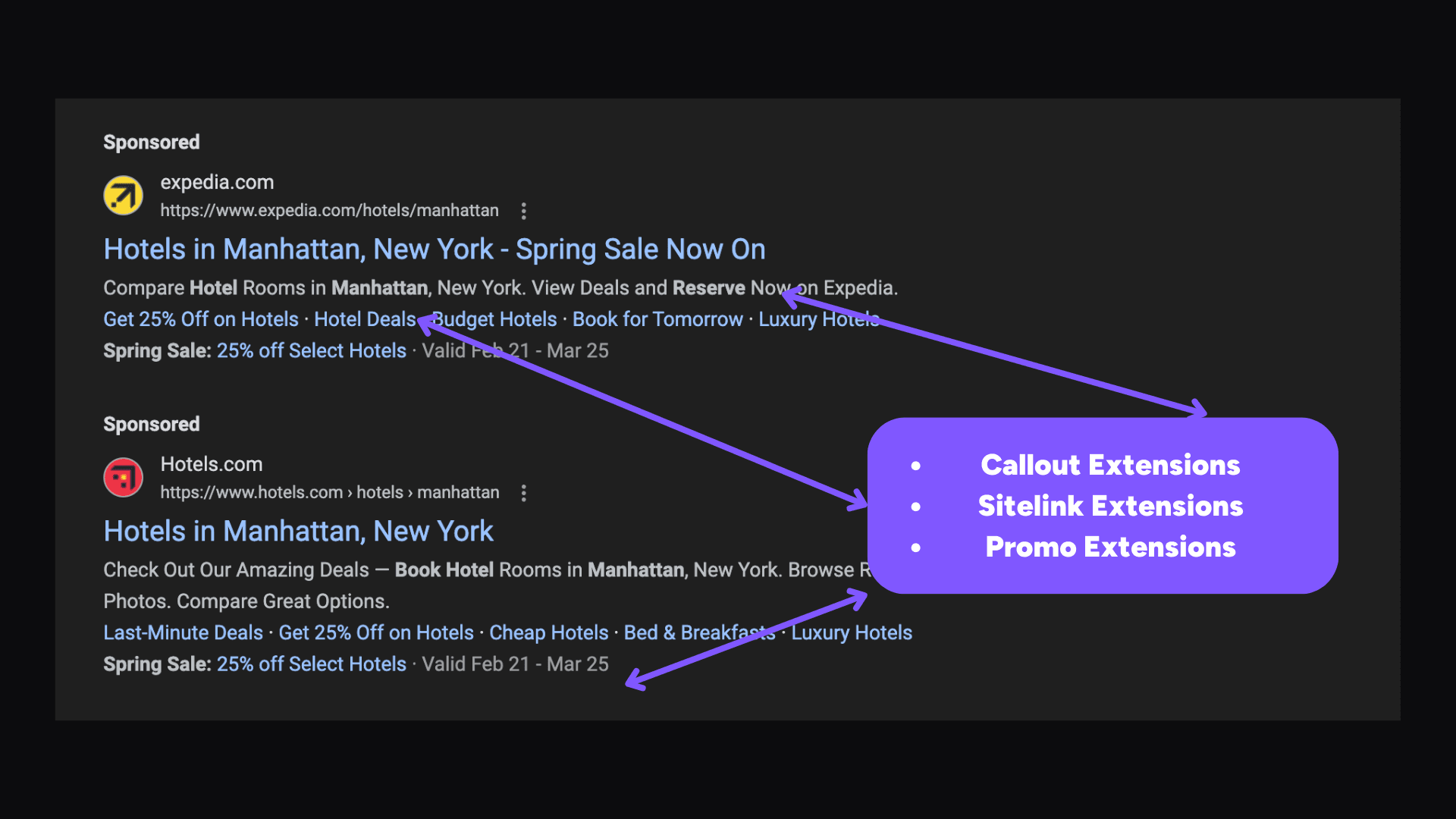
This is one part of the audit that we'll almost always find mistakes!
Account assets are the finer details that can add up to make the difference to your PPC results.
Example assets include:
- Sitelinks
- Callouts
- Locations
- Images
- Promotions
- Seller ratings
You add these at the account level within Google Ads.
Account Assets Checklist ✅
- At least 4 Site Links are present
- At least 6 Callout extensions are present
- Call extension is present
- Structured Snippets are presents
- Logo is present
- Images are present
- [Optional] Location extension(s)
- [Optional] Price extension where appropriate
These little touches can make all the difference in making your business stand out as trustworthy in the search results.
8) Ad Groups
Next up on our PPC audit checklist is Ad Groups.
For these, you should check individual ad groups across the account to make sure that they follow the patterns & rules established below for optimal performance.
Ad Groups Checklist ✅
- Keywords are divided in a logical and precise way
- E.G. keywords related to "website development services" all in one ad group.
- E.G. keywords related to "marketing services" all in one ad group.
- High impressions and high spend keywords are in tight ad groups of ~5 or less keywords
- These are your big "moneymaker" keywords.
- You want to keep them in very tight ad groups!
- These ad groups are not restricted by budget
- Your high impression / high spend keywords shouldn't be restricted by budget.
- They should have more allocation than other ad groups.
- Other ad groups do not contain a large number of keywords (20+)
- Outside your "moneymakers" don't include >20 keywords within one ad group
- Ad extensions have been tailored to (at least) the top performing ad groups
- Create custom ad extensions for your top ad groups
- That means text, ratings, images that are specifically catered to that ad group
9) Keywords

Keywords are probably the one area of an audit that most PPC marketers love to get their teeth sunk into 😬
It's also the one area that PPC amateurs get the most wrong, because they don't yet fully understand the implications of search intent and how that ultimately impacts the likelihood of converting visitors.
In addition, there's the added complexity of negative keywords to throw into the mix.
👉 It's a key stage of the audit, and one which top PPC pros should cherish.
Keywords Checklist
- Does your target keywords match with your business offer?
- This seems incredibly basic, but we've seen countless times businesses bidding on irrelevant keywords.
- Run a sense-check on all the search terms within Google ads just to make sure keywords don't look out of place.
- The chances are if you're doing a PPC audit for the first time, you'll find a few issues here.
- No significant difference between keywords match type and performance
- So this means for example if you're running a broad-match ad group & an exact-match group, there isn't a huge difference in performance.
- If there was a big difference in performance, you'll need to carefully review any under-performing ad-groups or campaigns accordingly.
- It might be that broad match is just generating poor quality leads and that you need to get tight with more exact-match terms.
- Brand is segmented - yes or no.
- Ensure you have a separate campaign for branded keywords.
- Important to have this segmented & separate from everything else.
- Broad keywords have negatives.
- Any broad keywords be using should have negative keywords present!
- This is to make sure Google doesn't start serving ads to irrelevant customers.
- This can be a particular problem with broad match keywords.
- Negative keywords are present
- Ensure that a good selection of negative keywords exist.
- These are keywords that you do not want to show ads for.
- For more inspiration on what negative keywords to add, see this guide.
- No more than 20 keywords per ad group (including match types)
- Any more than 20 primary keywords generally means you'll have too many irrelevant keywords in there.
- Aim for 15-20 keywords maximum in your ad groups, and less in your big "money maker" groups.
- This will ensure optimal performance.
- High spend or high volume keywords are showing for relevant search terms
- Sense-check the "search terms" report in Google Ads.
- Make sure that the search terms Google is serving your ad to are all strongly relevant.
- If not, you may need to pause certain keywords or add more negative keywords.
- High spend and/or volume keywords don't have a low quality score
- Google will provide a quality score of 1-10 on the keywords level.
- If a keyword has a low quality score it means that Google thinks there is a mis-match between the keyword and your advert / landing page.
- If you see anything with a quality score below 7 and that keyword is high-spend, then look into it!
- Read more about quality score here.
- Any unexpected keywords that bring in lots of conversions?
- If you are running broad match campaigns for long enough, one benefit is that often you'll discover great keywords you didn't know existed before.
- If you find any of these secret 'winners' in your search terms report, you might want to consider creating a new landing page for them, or moving them into a new dedicated ad group.
10) Adverts

Your PPC ad copy is key to success. During PPC audits, take the time to look at each one to see which ads perform strongly and which could do better.
Look for ads with a low click-through rate or those that aren’t performing as well as they once were: these could be good candidates for a content refresh.
We pay special attention to factors like:
- The ad copy: Is the ad copy readable, and does it make sense to the target audience?
- Call-to-action: Does it convey a clear offer that appeals to the buyer?
- Images: Are they relevant and enticing?
👉 Get our ads audit checklist below.
Ads Checklist ✅
- Each ad group has a minimum of 2 ads
- Google will automatically serve the best performing ads to the right users.
- Having this selection will just give you more chances of success.
- Ad groups have at least 2 distinct ads
- Add in 2 different variations to give Google's AI more ammmunition to work with.
- Use different ad copy and calls to action for each.
- Try some different headlines within each ad.
- No spelling or grammar issues
- Landing page has SSL cert - https://
11) Manual Bid Adjustments
This part of the PPC audit is optional and it's not something you should have to check on subsequent audits, but we like to always check to see if any manual bid adjustments are present on the account.
Manual Bid Adjustment Checklist ✅
- Keywords - If using manual bidding, the best keywords have appropriate bids
- Keywords - If using manual bidding, the worst keywords either bid low or are paused
- Device bid adjustments - Check if these are present and consider why
- Geography bid adjustments - Check if these are present and reasonable
- Demographics bid adjustments - Check if these are present and reasonable
- Schedule bid adjustments - Check if these are present and reasonable
12) Remarketing
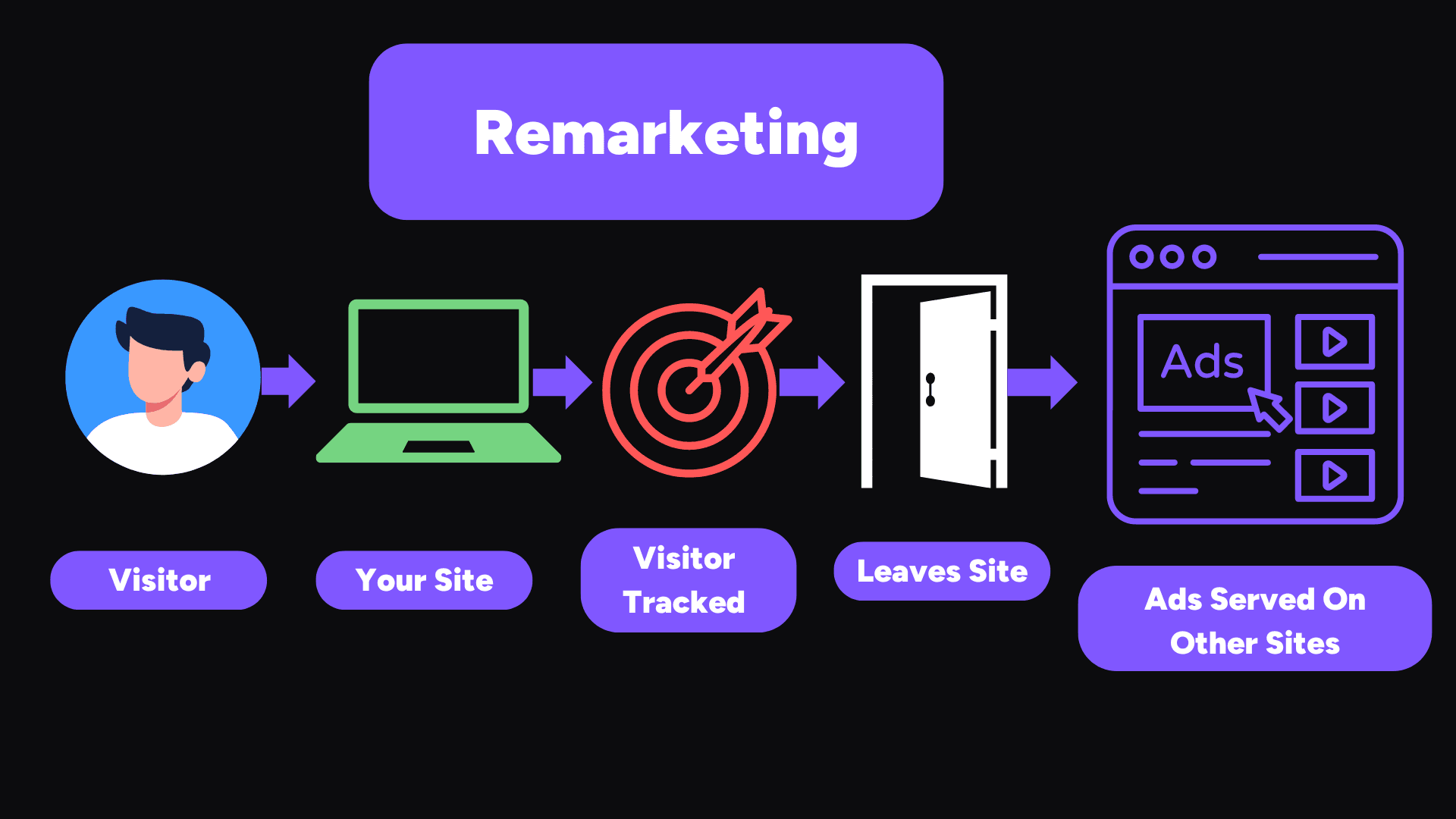
If you don't have a solid PPC remarketing strategy in place, then you're definitely missing out.
So this is an essential part of the audit to ensure you have this set up correctly, and that you're targeting specifically people who visited your site before but haven't yet purchased.
Remarketing Checklist ✅
- Remarketing lists for search ads (RLSA): are present in the account
- Target high-intent audiences: Are audiences segmenteted within your remarketing lists based on user behavior (e.g., abandoned cart, product page visits).
- Is Smart Bidding in Place for remarketing?
- Are ads tailored for previous visitors?
- Are broad keywords present to target prior visitors? (RLSA lets you be more competitive with broader terms.)
13) Landing Pages

This is by far my most favorite stage of the PPC audit - checking our landing pages!
We're big believers that landing pages more than anything else can lead to the best results for your PPC campaigns.
That's because as Google Ads becomes more automated and the level of skilled marketers gets more even, guess which part of the process cannot be automated?
The look & feel of the landing page that the user ends up on.
- If you have a great landing page, expect to convert like crazy.
- If you have a bad landing page, expect conversions and results to be abysmal.
It doesn't matter how good you are at PPC - If you're working with poor landing pages, you will never win.
Landing Pages Checklist ✅
- Landing pages are relevant and well-performing.
- Landing pages match ad groups and target keywords.
- Landing page has sufficient testimonials & social proof.
- Effective Call-to-Action (CTA) implemented.
- Form optimization and content is aligned.
- A/B testing is active.
- You can use tools like Unbounce or Optimizely to test out different versions of pages.
Remember - If you’re getting a high number of clicks but few conversions in your PPC account, the problem could be that your landing page(s) are ineffective and need work.
If you have some landing pages that perform better than others, check the high-performing ones to see what works. Apply these techniques to pages that aren’t doing as well.
14) Competitor Analysis
This is the fun part of the PPC audit, and actually goes way beyond just PPC.
Looking at what your competitors are doing with their PPC advertising will give you valuable business intelligence that you can use to keep on top of industry trends, and see if they're perhaps using certain marketing strategies or approach that you should consider for your business.
Competitor Analysis Checklist ✅
- Competitor ad copy checked
- My favorite methodology for this is a manual check.
- Simply type some of your major commercial keywords into Google and see what your competitors are doing.
- Are they mentioning interesting calls to action?
- Any promotions that might inspire you?
- Competitor keywords checked
- Use tools like SEMRush to see what your competitors are bidding on.
- You might notice a gap in your approach, and a keyword that you missed.
- You'll also be able to check if competitor's are bidding on your own brand name!
- Competitor landing pages checked
- How have your competitors designed their landing pages?
- How do their calls to action differ from yours?
- Are they offering contact options that you aren't? e.g. direct phone number?
- Competitor reviews export
- Grab all of your competitor reviews from Google or other major review platforms.
- Paste all those reviews into ChatGPT or Google Gemini and ask them to pick out the major benefits of your competitor.
- Now you'll have a list of potential new angles you can use in your PPC ads.
15) Full Customer Journey

In final part of the PPC audit, we're going to tie up loose ends in terms of exactly how our PPC marketing works within the entire customer journey.
We want to audit exactly how PPC ads are playing along with all of our other marketing & sales efforts, to ensure that everything is working in tandem together.
Customer Journey Checklist ✅
- PPC campaign messaging is synergized with social media & email marketing efforts.
- Remarketing campaigns are present on other ad platforms (like Facebook and Instagram)
- Lead nurturing is present - E.G. SMS and email flows to nurture leads toward eventually converting.
- Your CRM and call tracking has been fully integrated into Google ads.
+ Advanced PPC audit checklist:
- Analyze the full user conversion path to identify friction points.
- Generate dynamic landing pages for full customization.
- Audit the entire customer attribution journey to see which channels are having the most impact.
Can You Increase Revenue?
95% of this guide has talked about the specifics of auditing a PPC account.
It's incredibly important to go through all of these points diligently, and I can guarantee if you have done so, your account will certainly be stronger than most.
You'll have reduce wasted ad spend and identified multiple areas that can be significantly improved.
But if you really want to get World-class results from your PPC audit, then there's a final consideration to make.
Three Key Questions 🤫
If you can find a way to answer 'Yes' to any of the questions below, I can guarantee this will have a bigger impact on your PPC marketing efforts than anything else...
- Can we increase AOV (average order value)
- Can we increase customer LTV (customer lifetime value)?
- Can we upsell more immediately to customers?
The bottom line is - If you can find a way to increase your revenues and lifetime value per customer, you will see a far greater impact on your PPC performance than auditing any of the details we've discussed so far.
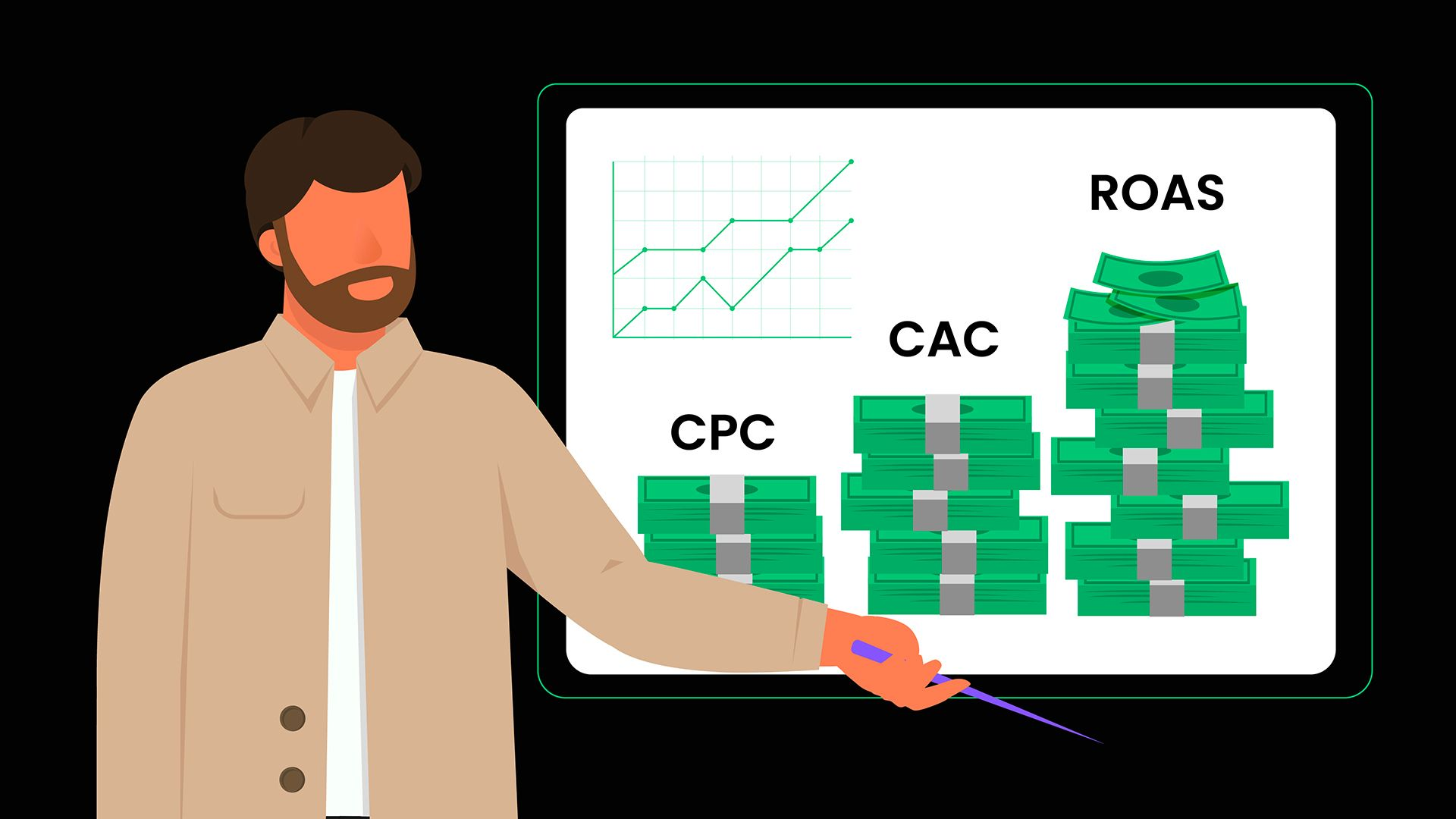
Case Study - Plunge.com
I'm going to finish our PPC audit article with a true story about Plunge.com.
They sell cold plunges, and they're generating over 1700% ROAS from their PPC marketing efforts.
👉 Key Points
- They're selling each product on average for around $6,000.
- It costs them $350 to acquire a customer through PPC.
- Their business economics and margins are so strong that PPC will always work for them as a marketing channel.
- Their content + product + offer is so good, that any PPC marketer would be able to help them print money.
Closing Thoughts
Running a comprehensive PPC audit is absolutely key.
But if you're not also auditing your business model & revenue per customer, then you're missing out.
That's why we love to combine some elements of business analysis into our PPC audits, and it's why we strongly recommend you do the same.
